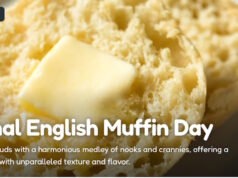
Don’t feel bleu, throw a feta or act capricious. January 20th is a gouda day to kummin over and have some cheddar or asiago or fontina! It’s National Cheese Lover’s Day.
The earliest record of cheese making dates back to 5,500 BCE in what is now Poland. Today there are over 1,400 varieties of cheese.
The nutritional value of cheese varies depending on the variety. Cottage and mozzarella cheese are at the lower end of fat and calories per serving while mascarpone and cream cheese pack it on. Marscapone makes desserts like tiramisu rich and creamy.
For cheese lovers who think one day is just not enough to celebrate cheese, National Day Calendar has you covered for the entire year. There are 18 other cheese specific holidays on the calendar from National Cheese Doodle Day (March 5) and National Grilled Cheese Sandwich Day (April 12) to Cheese Souffle Day (May 18), National Cheese Day (June 4), National String Cheese Day (September 20) and Moldy Cheese Day (October 9). Let’s also not forget; cheese makes excellent desserts. National Cheesecake Day is July 30, and there are three other flavors on the calendar along with National Cream Cheese Brownie Day just around the corner on February 10.
By celebrating National Goat Cheese Month in August, cheese lovers can celebrate 10 out of 12 months of the year. The last two months of the year do not celebrate cheese specifically but cheese there will be! National Nacho Day (November 6) just isn’t the same without the queso. On National Sangria Day (December 20), cheese lovers will enjoy serving a variety of cheeses with all their guests!
- Cheeses are more flavorful at room temperature. Let them stand for a half hour before serving.
- Cheese is an ancient food whose origins predate recorded history.
- Artisan cheese, made in small batches from local sources, is growing at a pace that exceeds even the growth rate of general cheese consumption in America.
- Some studies claim that cheddar, mozzarella, Swiss and American cheeses can help to prevent tooth decay.
- A study by the British Cheese Board in 2005 showed cheese has positive effects on sleep, not nightmares as Ebeneser Scrooge seemed to think.
- It takes 10 pounds of milk to make just 1 pound of cheese.
- Over 25% of cheese in the U.S. is made in Wisconsin (the rest comes mostly from California, Idaho and New York). More than half the nation’s artisan cheese is made in Wisconsin.
- Some cheeses are illegal in the United States. Because of safety concerns related to bacteria, the FDA has banned certain cheeses from entering the United States. These include cheeses made with raw milk and aged under 60 days, including Brie de Meaux, Reblochon, Valencay, Epoisses, Roquefort and Camembert de Normandie.
- Cheese caves are a real thing. Storing cheese in caves, whether natural or man-made, helps to age them and imparts another level of flavor. Caves are cool and humid, which is exactly what cheese needs to age properly.
- Mice don’t like cheese.
- There’s a reason certain cheese names are capitalized. If a cheese is named after a city (or country-hello, American!), it’s capitalized.
- There are 60 Master Cheesemakers in the United States…and every one of them lives in Wisconsin.
- Cheddar Cheese is never naturally orange. – Source
- The most stolen food item in the world is cheese, with 4% of all cheese being sold end up stolen. – Source
- When cheese is digested, it breaks down into an opioid. Other opioids you may know about are heroin and morphine. – Source
- Albertville, France’s electricity is powered by Beaufort cheese. Since whey is unnecessary to make Beaufort cheese, bacteria is added to the whey. This transforms the whey into biogas. This gas is then fed through an engine which heats water to 90°C (194°F) to generate 2800 MWh/yr of electricity. – Source
- Stilton blue cheese is known to frequently cause odd, vivid dreams. – Source
- Philadelphia cream cheese is named after a village in upstate New York, not the famous Pennsylvania city. – Source
- Scientists have successfully created cheese using human bacteria collected from toes and belly buttons. – Source
- Gouda accounts for over half of the world’s cheese consumption. – Source
- The oldest known cheese was from 1615 BC in China and resembles cottage cheese. – Source
- Moose cheese costs around $420 per pound, since each milking takes two hours, and must be done in complete silence. – Source
- Edam Cheese never goes bad, it only hardens. This resulted in its popularity at sea and in remote places. – Source
Sources:












